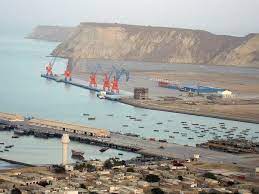 During a ceremony in Dera Ismail Khan on July 25th in the presence of the Prime Minister, Moulana Fazal ur Rehman made a stunning revelation about Gwadar port. He stated that Gwadar, which we trumpeted all over the world as the deepest sea port in the region capable of harbouring mother ships, which no other port in the area or neighbouring countries could, is no longer as deep as we thought, having already lost its depth from 18 metres to 11 metres and continuing to lose depth even now, and thus no mother ship or even large ship could dock here. This was such an eye-opening surprise that it prompted me to conduct further investigation on Maulana’s heartbreaking remarks. Yes, the assertion is valid, and it is possible that this is one of the reasons why the Gwadar port has yet to emerge as a significant port in the region or all over the world.
During a ceremony in Dera Ismail Khan on July 25th in the presence of the Prime Minister, Moulana Fazal ur Rehman made a stunning revelation about Gwadar port. He stated that Gwadar, which we trumpeted all over the world as the deepest sea port in the region capable of harbouring mother ships, which no other port in the area or neighbouring countries could, is no longer as deep as we thought, having already lost its depth from 18 metres to 11 metres and continuing to lose depth even now, and thus no mother ship or even large ship could dock here. This was such an eye-opening surprise that it prompted me to conduct further investigation on Maulana’s heartbreaking remarks. Yes, the assertion is valid, and it is possible that this is one of the reasons why the Gwadar port has yet to emerge as a significant port in the region or all over the world.
According to one study, which was published in the journal *Marine Geology* in 2022, the port is losing depth at a rate of roughly 1.5 centimetres per year. The authors of the study attributed this to a combination of natural forces, such as Indus River sediment transfer, and human actions, such as dredging and deforestation. Another study, published in 2021 in the journal *Environmental Science & Technology*, discovered that the port is also threatened by climate change. The authors of the study discovered that the sea level in the vicinity of Gwadar is increasing at a rate of roughly 3 millimetres per year, and that this is likely to accelerate in the future. Aside from dredging, one option was to minimise the quantity of silt delivered into the port by the Indus River, create seawalls to protect the port from flooding, and plant trees to assist stabilise the coastline.
The success of dredging, which is now the only short-term solution to restore Gwadar Port’s depth, is mostly dependent on the amount of sediments carried to the sea by Pakistan’s river system. According to a survey, the Indus River transports an estimated 300 million tonnes of silt to the Arabian Sea each year, which is increasing due to fast melting glaciers, insufficient forest cover, a lack of river water treatment, soil erosion, and human rubbish dumping. This silt, however, is necessary for the formation of the Indus River delta, which is a crucial environment for a variety of plants and animals and serves to safeguard the shoreline by producing sea bed sedimentation.
But it is easier said than done; the cost of dredging a port where 300 million tonnes of sediment are added every year must be a perpetual and continuous process that is prohibitively expensive and unsustainable, necessitating a permanent solution that involves cleaning the Indus water of sediments before it is discharged into the sea. The Port of Los Angeles recently finished a dredging project that cost $1.6 billion to dredge 20 million cubic yards of material, equivalent to 30 million tonnes of material, and transport it to a disposal location 20 miles offshore. Consider the cost of dredging 300 million tonnes of material transported to the sea each year by the Indus River alone.
During a preparatory meeting on China-Pakistan Economic Corridor (CPEC)’s Joint Working Group (JWG) on Transport Infrastructure held on 22 May, 2022, it was observed that due to negligence of the previous regime, the depth of Gwadar port has decreased to 11 metres which should be 18 metres deep for navigation of big ships; which is preventing the anchoring of big ships on the port. The meeting proposed urgent measures to initiate the dredging process at Gwadar Port so that Gwadar port will be made a viable transportation of big ships.
The Gwadar port dredging project was started in 2015 and was supposed to be completed in 2017, but it was delayed due to our notorious incompetence, incapacity, and vested interests, and as usual, blame was placed on the political situation in Pakistan and the lack of dredging equipment.The China Harbour Engineering Company Ltd (CHEC) is now dredging Gwadar Port with the goal of increasing the depth of the port’s navigational channel to at least 14.5 metres from its current depth of 11.6 metres. The dredging job is being done in two stages. Dredging the navigational channel is the first phase, which is presently underway. The second phase, which will commence after the first phase is finished, will include dredging the approach channels and berthing areas, which would cost Rs. 4.7 billion and is expected to be completed by the end of this year. However, the price will be affected by currency fluctuations, fuel costs, and labour charges. Once completed, it will allow larger ships to operate smoothly, enhance port capacity, and ensure smooth ship movements in the entry channel, which is critical for Gwadar Port’s future development.
Sedimentation is not the only issue confronting Gwadar port. Other issues include infrastructure and connectivity issues, political instability, law and order issues, a lack of trained and productive labour force, and the threat of terrorism and insurrection, to name a few. It is hampered by a lack of nearby road and rail networks, which are critical for efficiently delivering commodities to and from the port. It has formidable security problems because of its location in a sensitive region, Balochistan, which has been plagued by security issues and insurgency. Another factor discouraging international investors from committing to large-scale projects like the development of Gwadar port is Pakistan’s precarious economic and political situations. While Gwadar port is still under construction, regional countries have build several well-established ports, such as Dubai’s Jebel Ali, which already has a strong infrastructure and connectivity advantage, and Chabahar of Iran, which provides the shortest and safest route to India, Afghanistan, and Central Asian Republic to warm waters and connects them with the rest of the world. For example, while Gwadar Port was inaugurated on November 14, 2007, and Chabahar Port in Iran was inaugurated on December 3, 2017, Chabahar is attracting far more business than Gwadar, despite the fact that, unlike Gwadar, which is located on the mouth of the Strait of Hormuz, Chabahar Port is located on the Gulf of Oman and is a shallow-water port developed by India as a way to bypass Pakistan and connect India to Afghanistan and Central Asia.
The following is a comparative statement of the business won by these three ports in the last five years:
| Year | Gwadar Port | Jebel Ali Port | Chabahar Port |
| 2018 | $100 million | $15.3 billion | $ 150 million |
| 2019 | $ 120 million | $ 16.2 billion | $ 170 million |
| 2020 | $ 140 million | $ 17.1 billion | $ 190 million |
| 2021 | $ 160 million | $ 18 billion | $ 210 million |
| 2022 | $ 180 million | $ 18.9 billion | $ 230 million |
The myth of Pakistan offering a warm water port of Central Asian is also broken as Chabahar is nearer to Central Asian countries. It is fully operational and well connected with the interior of Iran and Central Asian countries by road and rail links without being marred by any security or safety, law and order or political instability issues. Whereas, Gwadar port is poorly linked via road links, has no train links as it now suffers from security and safety, law and order and uncertain economic and political issues. Have a look at the country wise distance of Central Asian countries to Gwadar and Chabahar:
| Country | Distance from Gwadar Port (km) | Distance from Chabahar Port (km) |
| Afghanistan | 1,060 | 760 |
| Kazakhstan | 2,500 | 1,500 |
| Kyrgyzstan | 2,800 | 1,800 |
| Tajikistan | 2,300 | 1,300 |
| Turkmenistan | 1,700 | 900 |
The pace of development of Gwadar port is though facing multiple challenges but fact remains that Gwadar Port is more suitable for regional and international trade compared to other ports in the region for a number of compelling reasons including but not limited to; it is located on the Arabian Sea, at the mouth strait of Hormuz, which gives it easy access to major trade routes in the Indian Ocean and the Middle East, the Strait of Hormuz is a major shipping lane that connects the Persian Gulf to the Arabian Sea and has the potential to boost economic development in Pakistan and the region, create jobs, attract investment, and facilitate trade.
It is a valuable asset to Pakistan and the region. It was a deep sea port with a depth of 14.5 metres (now 11.5 metres), allowing it to handle huge container ships, something many other ports in the region do not have due to shallower water depths. It has less depth than Jebel Ali Port, which has a depth of 17 metres and is the deepest port in the Middle East, allowing it to handle huge container ships. Gwadar is superior to Chahabahar, whose depth ranges from 2 to 11 metres but is still deep enough to accommodate some large container ships. Gwadar Port has the potential to become a significant transhipment centre for the region, which means goods might be brought to Gwadar Port and then transferred to other ships for further transportation.
Like many other projects Gwadar port is facing our trademark, inefficiencies, vested interests, corruption, lack of competency, capacity and above all lack of political will. As a nation, if we want to make Gwadar port a success we have to set our direction right, automate processes, private the businesses and processes to bring efficiency, make it a free port which have least amount of government interferences otherwise like all other public sector assets which are bleeding wound to the national exchequer, we will add one more white elephant into them, and then we will be offering special prayers for making Gwadar port a success and for progress and prosperity of our country which uptill now has not worked.
The author is the former Press Secretary of the President of Pakistan, the former Press Minister of the Embassy of Pakistan in France and also has been the former MD / CEO Shalimar Recording and Broadcasting Company (SRBC)


